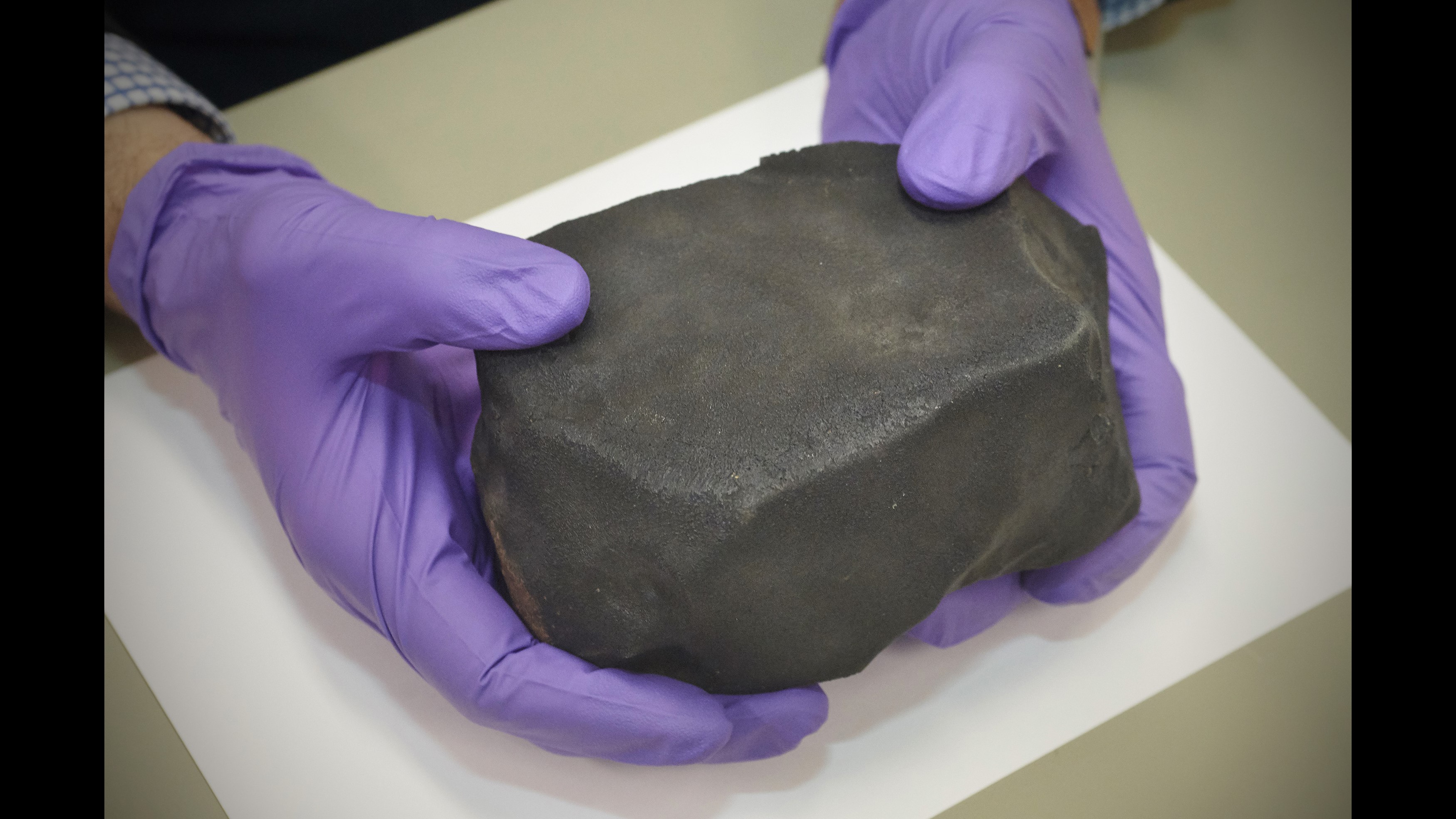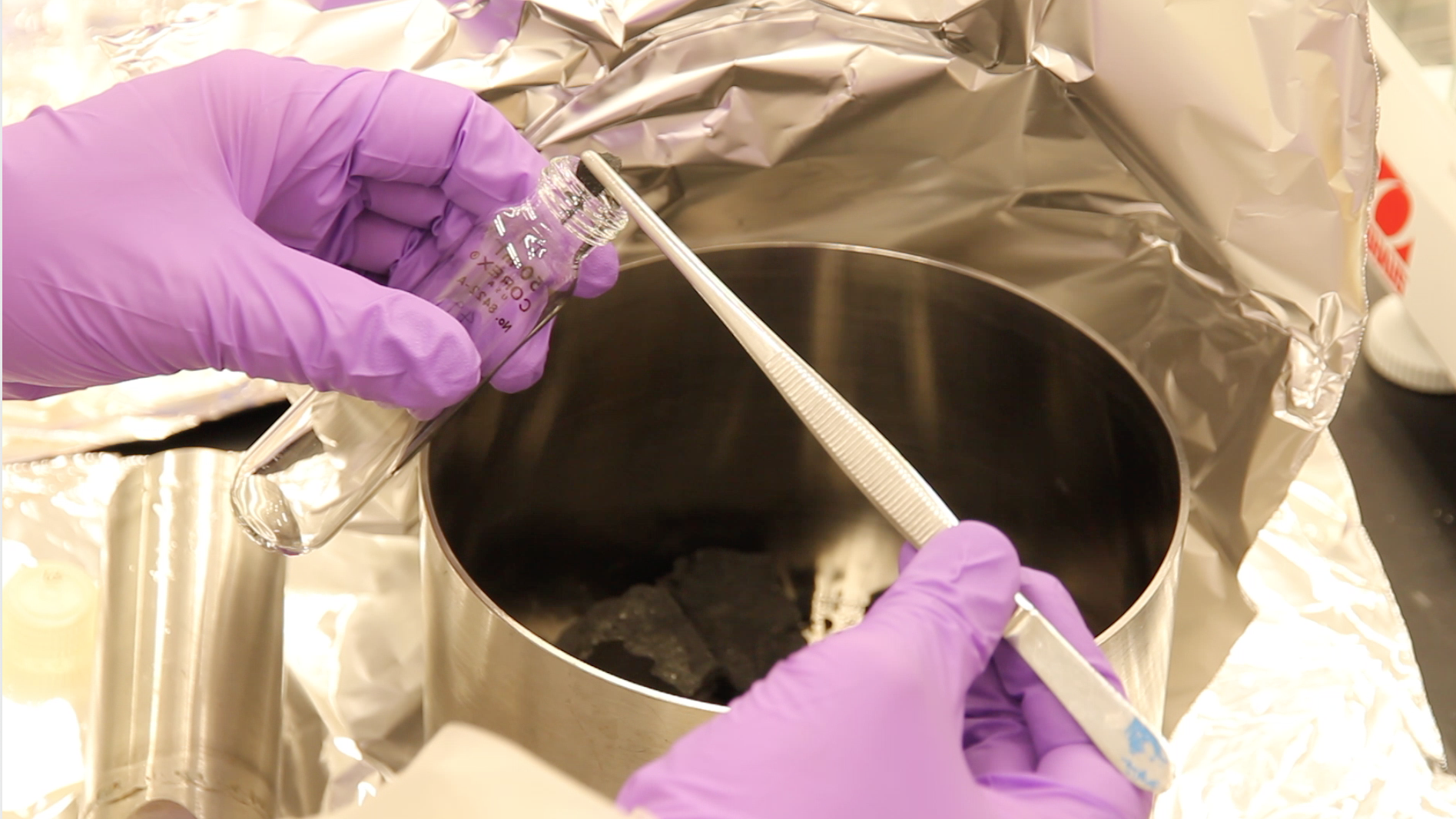Bizarre meteorite is 1st to show scars from pebble-shooting asteroid

A meteorite on Earth holds new evidence that asteroids do indeed mysteriously spit out pebbles, a new study finds.
In 2019, NASA's OSIRIS-REx spacecraft discovered a strange new phenomenon when the near-Earth asteroid it was exploring, Bennu, appeared to shoot swarms of marble-sized rocks into space. Scientists still don't understand why exactly this activity happens, but a chance analysis of a meteorite may shed light on the puzzling behavior.
Scientists analyzed the Aguas Zarcas meteorite, named after the Costa Rican town where it fell to Earth in 2019. Meteorites can be made of bits of moons and planets, but most often, they are shards of asteroids. The Aguas Zarcas meteorite's carbon-heavy composition suggested it came from a carbon-rich asteroid much like Bennu.
Related: The greatest asteroid missions of all time!
The researchers were actually preparing the Aguas Zarcas meteorite for a different study that required processing the rock in a particular way.
"We were trying to isolate very tiny minerals from the meteorite by freezing it with liquid nitrogen and thawing it with warm water, to break it up," study lead author Xin Yang, a graduate student in geochemistry at the University of Chicago said in a statement. "That works for most meteorites, but this one was kind of weird — we found some compact fragments that wouldn't break apart."
Most scientists would simply crush the fragments and move on with their research, study senior author Philipp Heck, the curator of meteoritics at the Field Museum in Chicago, said in the same statement.
Get the Space.com Newsletter
Breaking space news, the latest updates on rocket launches, skywatching events and more!
But this time, the researchers instead decided to analyze what these pebbles were and why they were so resistant to breaking apart. "Xin had a very open mind," Heck noted. "He said, 'I'm not going to crush these pebbles to sand; this is interesting.'"
The scientists used CT scanning, the same technique doctors use to see inside a patient's body, to compare the pebbles with the rest of the meteorite. "What was striking is that these components were all squished — normally, they'd be spherical — and they all had the same orientation," Heck said in the statement. "They were all deformed in the same direction, by one process."
These characteristics suggested the pebbles had experienced something the rest of the meteorite hadn't. "This was exciting, we were very curious about what it meant," Yang said in the statement.

Computer models that the research team developed suggested the asteroid from which the Aguas Zarcas meteorite came may have undergone a high-speed collision. Then, huge temperature differences may have broken apart deformed rock at the impact site as the asteroid spun. (The day and night sides of an asteroid can be 300 degrees Fahrenheit (150 degrees Celsius) different.)
"This constant thermal cycling makes the rock brittle, and it breaks apart into gravel," Heck said in the statement. And that gravel may be what an asteroid like Bennu is spitting out, the scientists think, although they aren't sure what mechanism may be ejecting the rock, although small impacts or thermal stress might do the trick. In any case, once the pebbles got ejected, they would not need much of a push to escape the asteroid's weak gravitational pull and slip into a very slow orbit.
Then, the researchers suspect, the pebbles eventually fell back down to the asteroid's surface away from the initial impact site — only for the asteroid to endure another collision. This impact "basically packed everything together, and this loose gravel became a cohesive rock," Heck said in the statement, and may have dislodged the new rock to hurtle out into space and eventually fall to Earth as a meteorite.
If the researchers' explanation proves true, the Aguas Zarcas meteorite would make the space rock the first meteoritic evidence of asteroid-spitting.

"It's fascinating to see something that was just discovered by a space mission on an asteroid millions of miles away from Earth, and find a record from the same geological process in the museum's meteorite collection," Heck said.
The process the researchers describe may also offer a new way of understanding how rocks on an asteroid's surface mix together. Scientists have long assumed the main way this happens was through larger impacts, but such crashes do not happen very often. Pebble spitting might.
"From OSIRIS-REx we know that these particle ejection events are much more frequent than these high-velocity impacts," Heck said in the statement. "So they probably play a more important role in determining the makeup of asteroids and meteorites."
Although Aguas Zarcas may be the first meteorite to show signs of this behavior, it may not be the only one.
"We would expect this in other meteorites," Heck said. "People just haven't looked for it yet."
The scientists detailed their findings online Thursday (Aug. 11) in the journal Nature Astronomy.
Follow us on Twitter @Spacedotcom and on Facebook.
Join our Space Forums to keep talking space on the latest missions, night sky and more! And if you have a news tip, correction or comment, let us know at: community@space.com.

Charles Q. Choi is a contributing writer for Space.com and Live Science. He covers all things human origins and astronomy as well as physics, animals and general science topics. Charles has a Master of Arts degree from the University of Missouri-Columbia, School of Journalism and a Bachelor of Arts degree from the University of South Florida. Charles has visited every continent on Earth, drinking rancid yak butter tea in Lhasa, snorkeling with sea lions in the Galapagos and even climbing an iceberg in Antarctica. Visit him at http://www.sciwriter.us









